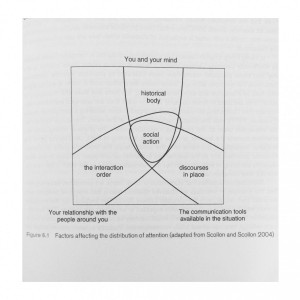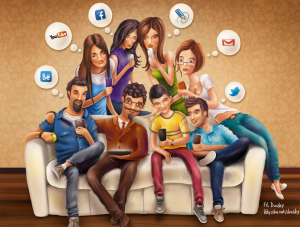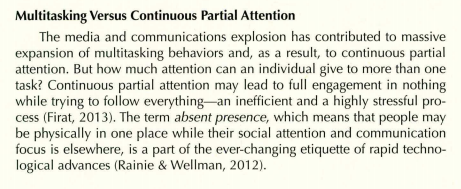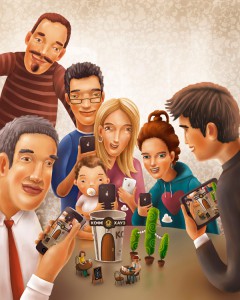Understanding Attention Structures
Once Upon An Attention Structure…
Our attention has for a long time been directed in a very narrow tunnel; It can be best explained as there being a starting point and one ending point, but with different angles of focus. In recent years, however, due to social media and digital media integration into our everyday lives our attention has been shifted in having a point starting but having multiple branches and numerous focus points without a definite ending point. Social media has enabled or forced us to focus our attention in ways we might not be fully aware of. In the self-conducted experiment ‘Signed Off‘, I tracked how my attention structure shifted in a matter of two weeks by detaching myself completely from all social media sites. The transition was eye-opening to witness, due to the fact that I was not completely aware of just how much my involvement or participation in these social networking sites changed the way I paid attention, what I pay attention to, who I give my attention to, and how certain aspects of the sites demanded attention. ‘Signed Off’ allowed me to hone in on how my attention had changed and potentially how social media has changed all of our attention structures.
Attention Structures – Whats the Sitch?
In Understanding Digital Literacies,1 by Rodney H. Jones and Christopher A. Hafner, they explain in their chapter “Attention Structures” as, “Attention structures are the technology means used by people to make sense of the overabundance of information that they face in the digital age” (87) 2. They went on to explain that this structure is then effected by three elements:
- Historical body –You and Your mind
- Interaction order – Your relation with the people around you
- Discourses in place – The communication tools available in the situation

- Courtesy of: Understanding Digital Literacies (pg.87)
These elements give way to attributing that the way we pay attention is neither completely in our own minds or completely outside of it, but a combination of both. Jones and Hafner, argue that if and when these elements or components of attention flow or sync in a way that we may tend to feel that our attention is, “flowing right, that we’re attending to what we need to attend to, we’re doing our jobs efficiently.”(87)3. In a community such as Instagram, it is hard not to believe that these elements are not working together. Your historical body is engaged in your posting of media, you are in constant relation with others, and you are constantly commenting, liking, direct messaging, or sharing. You are using all of these elements but is it really in an efficient way? With my detachment came the affordance of being able to see just how attention I poured into sites like Instagram and how much it cost me. In social networking sites such as Instagram 4, attention standards are set silently.
As we may all know, there is a certain criteria for the photos we post, the things we like, the people and products we engage in; it is to be apart of the attention and to generate our own attention. When I became disconnected, my social action moved from my social networking sites. I began to pay attention to the people around and zoned into the relations we had. I was able to see how communication tools were not available in real life. I could not delete or update the words I said so I had to pay keen attention to the things I said. I began to notice words as they left a speakers mouth, I noticed tone and did not have to guess it; by my attention being shifted I was able to live in the world again before social media and I could see this world in a bigger picture instead of a feed of constantly updated ones.
In many or all social media sites, a users’ attention is often demanded without much noticing. We are constantly bombarded with new features that draw our attention more. Twitter’s recent addition of Moments 5 has only created another new way for us to localize our attention in a community. The way we divide our attention is what Jones and Hafner call attention tracks. Attention tracks are the way we distribute our attention among a variety of things (85)6 . In the case of Twitter’s Moments, we are focusing our attention upon specific hashtags or tweets which allow us to dive deeper into a conversation of a particular community or event. These attention tracks are often accompanied by the illusionary attention which as explained by Jones and Hafner is the illusion of personal attention even though they are addressing a larger audience, for example, automatic replies, away messages, reminders, as well as filtering. Even when we are not directly paying attention to social sites our attention is still being given. We are constantly immersing ourselves and this immersion has led to new ways of how we focus this attention and how our attention is enticed.
I was curious, however, this new generation or generation Z 7 (born from 1993-2005), as it has been coined, has been surrounded by a high volume of technology since birth, so have we since then have our attention structures altered? According to Anthony Turner, author of, “Generation Z: Technology and Social Interest.”8 , the answer is yes. Turner states that “Hours of television viewing in children aged 1-3 has been linked to high risk (10%) of attention problems at the age 7” (110) 9. So from having our attentions shaped by television, we move onto having them shape by social media. We now cannot separate social media from television and this integration has led to more divided attentions not only among platforms but also types of media. We may never know what our attention structures have the potential to be due to this conditioning from society and the constant need for social media to be integrated with technology.
To move on, without my attention being demanded by the celebrity posts in The Shaderoom 10, or the need to engage in an explicit meme which I felt needed to be shared, or the responsibility I felt to give my attention to a conversation due to the fear of missing out 11; I was able to focus in on the world around me, divide my attention equally, and open my mind to paying attention to more than what was presented to me but what I saw that needed my attention. This disconnect although short, enables me to retrain myself to focus my attention, become less of an ‘absent presence’ a term coined by Turner. Being absent present meant that an individual was in one place physically but in another socially. I became present in all aspects of my life now; conversations no longer had missed information because I was mentally elsewhere.
According to Jean-Sébastien Chouinard of Adviso, this is a common aspect of Hyperconnectivity. In his article, “When Hyperconnectivity Leads to Social Alienation“ 12, he states that due to our constant attention online we have lost our ability to pay attention to the world around us. This has also led us to lose our personalities because without our social media and our attention given to it we become as he said nothing. He goes onto to coin the term JOMO or the Joy Of Missing Out 13 which essentially is the joy of being a part of the moments around us. To pay attention to our real lives and find space from our online social lives. Turner, Chouinard, and myself due to ‘Signed Off’ have been able to understand attention beyond social media and understand that we must train ourselves to give our attentions to various other aspects of life besides social networking sites.

- (Photo from ‘Signed Off’ Digital Diary)
With the disconnect, I was able to measure my attention track and the way in which my time got lost. Without social media, I was able to devote or pay more focused attention to one task at a time. I became more efficient and much more invested and aware in what I was doing. Work that would have gotten my divided attention was now being devoted to. In my blog post, “Attention Attention Attention” 14, of the Digital-Dairy, a key component to the experiment, I addressed the fact that now my attention was being focused on the world around me. No longer was I continuously checking a feed in 5-minute intervals to see updates but I was consciously noticing and focusing in on what I was doing and what was around me (also see: New Beginnings 15).

Friends by Fil Dunsky
Taking a few steps backwards, I knew when I began this experiment that of course my attention would be shifted due to the fact that I was cutting out a large portion of what I focus most of my attention in, however, what I did not expect was the way in which my attention widened both in span and stimuli. Often times on social media, I focused on few things—the things of which I find interesting which often goes from me giving my continuous partial attention to full on in a matter of minutes. As being a generation that has grown up with so much technology readily available it has in a way become innate for us to have continuous partial attention. Which means that we are, “constantly but partially, attending to information from our communication devices… (Jones, Hafner 82)16. This continual partial attention structure has allowed us to switch from one activity (Cast Switching), and pay attention to two important activates while switching back and forth (Dual Activity). Turner would explain how continual partial attention has led to what he states as, “full engagement in nothing while trying to follow everything—an inefficient and highly stressful process.” (111)17.

Screenshot from “Generation Z: Technology and Social Interest” by Anthony Turner

- Coffee House by Fil Dunsky
With these new ways of focusing our attention, many social networking sites and their users have started to become dramatically creative with the ways in which they attract our attention. Attention economies have been developed where there is a value created from the exchange of attention, the redefinition of the hashtag that now enables selective attention and calls for a direct demand of attention, the “@” that gives explicit attention to a person, place, or thing, not to mention the variety of creative outlets that are opened to engage our attention for hours at a time. Marketing strategies 18 have arisen to help users and administrators of sites to only influence attention but also generate attention. For instance, Vine 19 with their 6-second video limit has allowed us to pour our attention into not only creating but consuming vast amounts of video without the realization of how much attention we are allocating for the community. Not to forget, the aspect of a feed which all social sites have which encompass a variety of information and media that can lead us in any direction. Lastly, the idea that attention is generated often times on stupid, violent, and provocative posts majority off users often engage in such behavior to attain trending standards as well as popularity.
Attention structures are directly affected by social media because social media has created ways by which information in various mediums is narrowed down to offer the gist of a story. No longer are our attentions given the ability to grow in a sense of span. We are forced to prefer shorter and more concise work which embody and the entire event. Our attention pays the price because we become stuck in our ways due to the channel hashtags and other byproducts of social media create. Our imagination, human curiosity, and creativity has become limited because we pay attention to few sources of information because their lack thereof being included or adopted by certain hashtags. The sounds we hear and the faces we see are muddled by our social media presence. We look up and quickly return back to our mediated lives.
These forces are all creating students, discourse community members, and readers that have lessened abilities to have greater attention structures because although we are engaging in so many activities the takeaway is smaller, and the end products are narrower. For everyone who comes across this post, I hope that you take the time to disconnect yourself and open your attention to more than just what is presented to you in the mediated format which it is. Social media is a great affordance of our technologically savvy world, but time and attention paid to the world outside allows to build our attention structures to then apply it to our media outlets. This order allows us to regain more of our cognition as well as our ability of judgment.
Sources Cited:
1| Jones H. Rodney, Hafner. A Christopher (n.d.) In Facebook [Book Page] Retrieved November 17, 2015, from https://www.facebook.com/UnderstandingDigitalLiteracies/info/?tab=page_info
2| Jones H. Rodney, Hafner. A Christopher, “Attention Structures” in Understanding Digital Literacies (New York: Routledge, 2012) 87
3| Jones H. Rodney, Hanfer. A Christopher, “Attention Structures” in Understanding Digital Literacies (New York: Routledge, 2012) 87
4| Orlando, J. Charles. “Attention Instagram “models”: You are selling yourselves” The Problem with Women is Men. February 20, 2015. Web. Dec 5th, 2015.
5| Twitter (n.d.) In Twitter [About Page]. Retrieved, December 7th, 2015, from https://about.twitter.com/moments
6| Jones H. Rodney, Hafner. A Christopher, “Attention Structures” in Understanding Digital Literacies (New York: Routledge, 2012) 85
7|Williams, Alex. “Move Over, Millennials, Here Comes Generation Z” The New York TImes [New York] 18 September 2015. Fashion & Style. Web.
8|Turner, Anthony. “Generation Z: Technology and Social Interest.” Journal of Individual Psychology (2015): 103-113. Web.
9|Turner, Anthony. “Generation Z: Technology and Social Interest.” Journal of Individual Psychology (2015): 103-113. Web.
10|Angie. The Shaderoom. n/a n/a 2013. Web. 20 November 2015.
11| Dykman, April. “The Fear of Missing out”. Forbes.com 01 March 2012. Personal Finance. web. 21 November 2015.
12|Chouinard, Jean-Sebastien. “When Hyperconnectivity Leads to Social Attention” Adviso.com. 20 February 2013. n/a. web. 28 November 2015.
13|Chouinard, Jean-Sebastien. “When Hyperconnectivity Leads to Social Attention” Adviso.com. 20 February 2013. n/a. web. 28 November 2015.
14|Rajah, Mariah. “Signedoffblog.com.” 27 November 2015. Attention Attention Attention. Web. 15 December 2015.
15|Rajah, Mariah. “Signedoffblog.com.” 20 November 2015. New Beginnings. Web. 15 December 2015.
16|Jones H. Rodney, Hafner. A Christopher, “Attention Structures” in Understanding Digital Literacies (New York: Routledge, 2012) 82
17|Turner, Anthony. “Generation Z: Technology and Social Interest.” Journal of Individual Psychology (2015): 103-113. Web.







